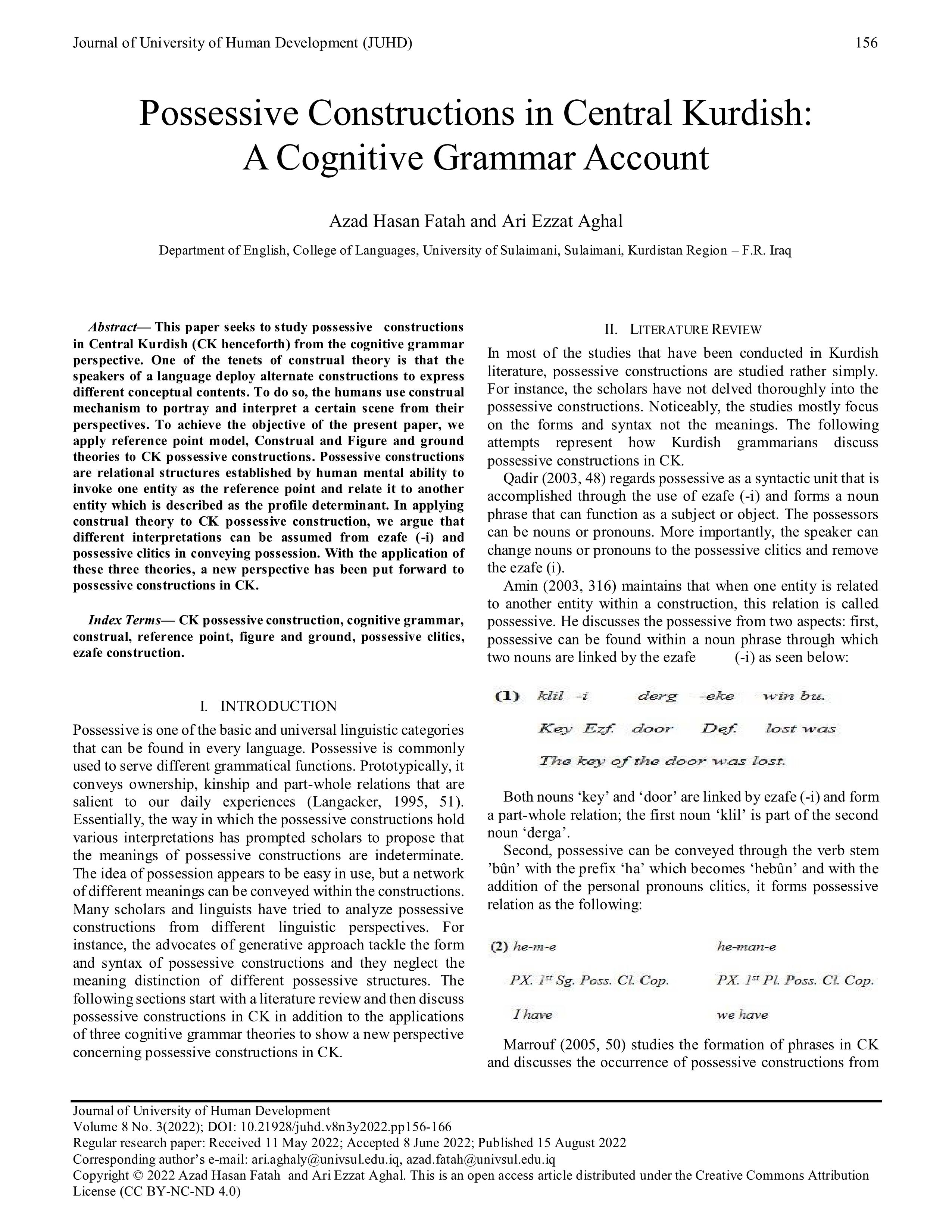Possessive Constructions in Central Kurdish: A Cognitive Grammar Account
DOI:
https://doi.org/10.21928/juhd.v8n3y2022.pp156-166Keywords:
CK possessive construction, Cognitive grammar, Construal, Reference point, Figure and ground, Possessive clitics, Ezafe construction.Abstract
This paper seeks to study possessive constructions in CK henceforth from the cognitive grammar perspective. One of the tenets of construal theory is that the speakers of a language deploy alternate constructions to express different conceptual contents. To do so, the humans use construal mechanism to portray and interpret a certain scene from their perspectives. To achieve the objective of the present paper, we apply reference point model, Construal and Figure and ground theories to CK possessive constructions. Possessive constructions are relational structures established by human mental ability to invoke one entity as the reference point and relate it to another entity which is described as the profile determinant. In applying construal theory to CK possessive construction, we argue that different interpretations can be assumed from ezafe (-i) and possessive clitics in conveying possession. With the application of these three theories, a new perspective has been put forward to possessive constructions in CK.
References
Ahmed, S.I., 2018. A Generative Study of Possessive Constructions in English and Central Kurdish Doctoral dissertation, Koya University.
Amin, O.W., 2003. Another Perspective of Linguistics, Aras publication No. 900
Hamawand, Z., 2020. Modern Schools of Linguistic Thought: A crash course. Springer Nature.
Langacker, R.W., 1993. Reference-point
Constructions.
Langacker, R.W., 1995. Cognitive grammar. In Concise History of the Language Sciences (pp. 364-368). Pergamon.
Langacker, R.W., 2008. Cognitive grammar (pp. 29-68). De Gruyter Mouton.
Langacker, R.W., 2009. In Investigations in Cognitive Grammar. De Gruyter Mouton.
Marrouf, M. A., 2005. Phrase Formation
In Kurdish, Kurdology Publication Center,
Sulaimani.
Petrova, N., 2016. Figure and Ground,
Sciodis [Available at: http://scodis.com/
for-students/glossary/figure-and-ground/]
Qadir O. A., 2003. A Comparative Study of Morphosyntax in Kurdish and Persian Doctoral Dissertation, Sulaimani University
Talmy, L., 1975. Figure and Ground in Complex Sentences. In Annual meeting of the Berkeley linguistics society (Vol. 1, pp. 419-430).
Tahir, R.S., 2018. The structure of DP in Central Kurdish (Doctoral dissertation, Newcastle University).

Downloads
Published
How to Cite
Issue
Section
License
Copyright (c) 2022 Azad Hasan Fatah , Ari Ezzat Aghal

This work is licensed under a Creative Commons Attribution-NonCommercial-NoDerivatives 4.0 International License.


